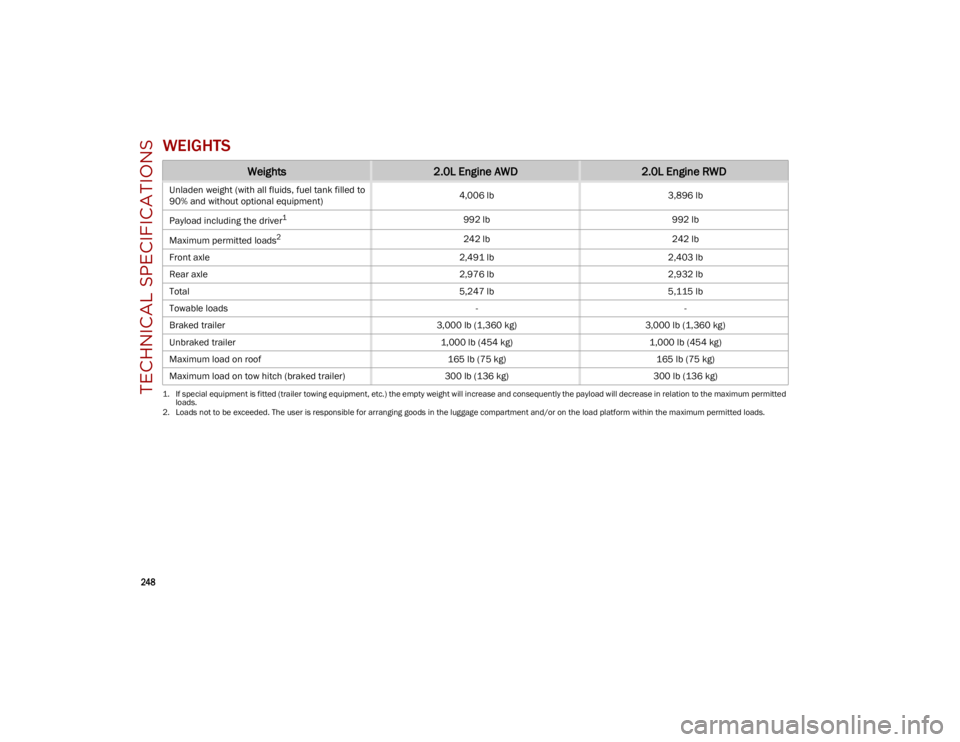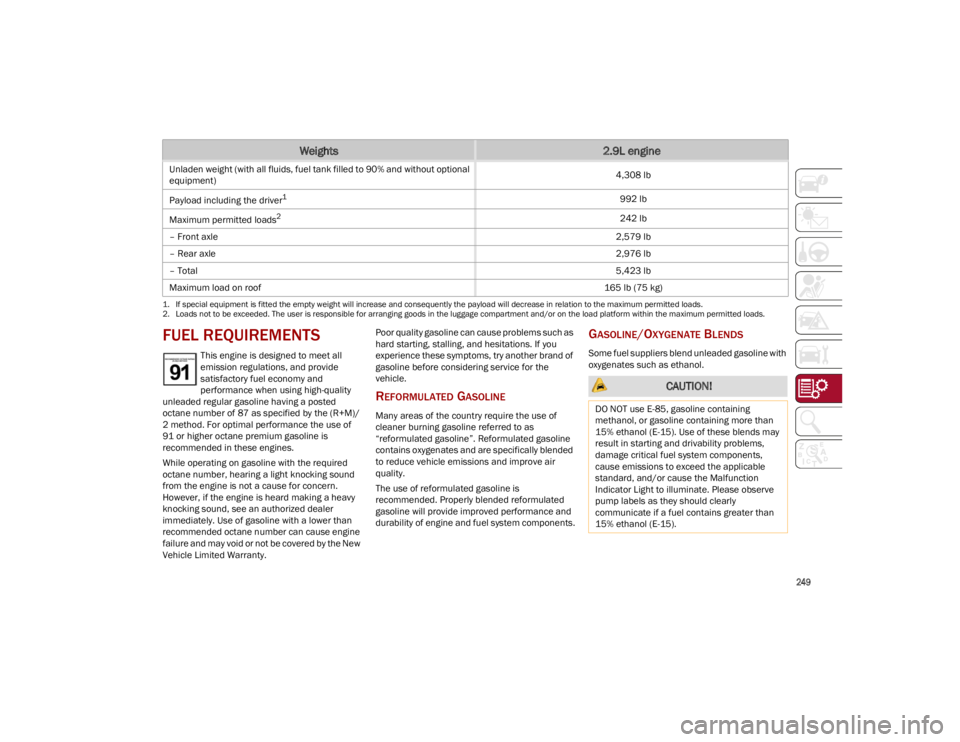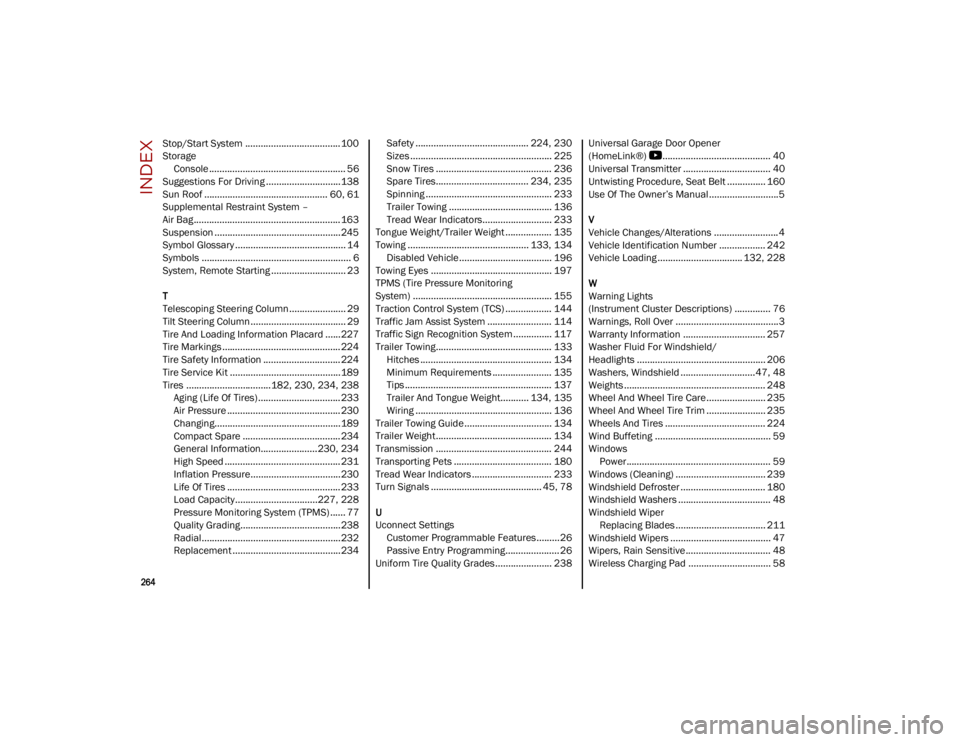2023 ALFA ROMEO STELVIO roof
[x] Cancel search: roofPage 168 of 268

SAFETY
166
Supplemental Side Air Bag Inflatable Curtains
(SABICs)
This vehicle is equipped with Supplemental Side
Air Bag Inflatable Curtains (SABICs).
Supplemental Side Air Bag Inflatable Curtains
(SABICs) are located above the side windows. The
trim covering the SABICs is labeled “SRS AIRBAG”
or “AIRBAG.”Supplemental Side Air Bag Inflatable Curtain (SABIC) Location
SABICs may help reduce the risk of head and
other injuries to front and rear seat outboard
occupants in certain side impacts, in addition to
the injury reduction potential provided by the seat
belts and body structure.
The SABIC deploys downward, covering the side
windows. An inflating SABIC pushes the outside
edge of the headliner out of the way and covers
the window. The SABICs inflate with enough force
to injure occupants if they are not belted and
seated properly, or if items are positioned in the
area where the SABICs inflate. Children are at an
even greater risk of injury from a deploying air
bag. The SABICs may help reduce the risk of partial or
complete ejection of vehicle occupants through
side windows in certain side impact events.
Side Impacts
The Side Air Bags are designed to activate in
certain side impacts. The Occupant Restraint
Controller (ORC) determines whether the
deployment of the Side Air Bags in a particular
impact event is appropriate, based on the
severity and type of collision. The side impact
sensors aid the ORC in determining the
appropriate response to impact events. The
system is calibrated to deploy the Side Air Bags
on the impact side of the vehicle during impacts
that require Side Air Bag occupant protection.
In side impacts, the Side Air Bags deploy
independently; a left side impact deploys the
left Side Air Bags only and a right-side impact
deploys the right Side Air Bags only. Vehicle
damage by itself is not a good indicator of
whether or not Side Air Bags should have
deployed.
The Side Air Bags will not deploy in all side
collisions, including some collisions at certain
angles, or some side collisions that do not impact
the area of the passenger compartment. The Side
Air Bags may deploy during angled or offset
frontal collisions where the front air bags deploy.
Side Air Bags are a supplement to the seat belt
restraint system. Side Air Bags deploy in less time
than it takes to blink your eyes.
WARNING!
Do not mount equipment, or stack luggage or
other cargo up high enough to block the
deployment of the SABICs. The trim covering
above the side windows where the SABIC
and its deployment path are located should
remain free from any obstructions.
In order for the SABICs to work as intended,
do not install any accessory items in your
vehicle which could alter the roof. Do not add
an aftermarket sunroof to your vehicle. Do
not add roof racks that require permanent
attachments (bolts or screws) for installation
on the vehicle roof. Do not drill into the roof
of the vehicle for any reason.
WARNING!
Occupants, including children, who are up
against or very close to Side Air Bags can be
seriously injured or killed. Occupants,
including children, should never lean on or
sleep against the door, side windows, or area
where the side air bags inflate, even if they
are in an infant or child restraint.
Seat belts (and child restraints where
appropriate) are necessary for your
protection in all collisions. They also help
keep you in position, away from an inflating
Side Air Bag. To get the best protection from
the Side Air Bags, occupants must wear their
seat belts properly and sit upright with their
backs against the seats. Children must be
properly restrained in a child restraint or
booster seat that is appropriate for the size
of the child.
23_GU_OM_EN_USC_t.book Page 166
Page 250 of 268

TECHNICAL SPECIFICATIONS
248
WEIGHTS
Weights2.0L Engine AWD2.0L Engine RWD
Unladen weight (with all fluids, fuel tank filled to
90% and without optional equipment) 4,006 lb
3,896 lb
Payload including the driver
1
1. If special equipment is fitted (trailer towing equipment, etc.) the empty weight will increase and consequently the payload will decrease in relation to the maximum permitted loads.
992 lb 992 lb
Maximum permitted loads
2
2. Loads not to be exceeded. The user is responsible for arranging goods in the luggage compartment and/or on the load platform within the maximum permitted loads.
242 lb 242 lb
Front axle 2,491 lb2,403 lb
Rear axle 2,976 lb2,932 lb
Total 5,247 lb5,115 lb
Towable loads --
Braked trailer 3,000 lb (1,360 kg)3,000 lb (1,360 kg)
Unbraked trailer 1,000 lb (454 kg)1,000 lb (454 kg)
Maximum load on roof 165 lb (75 kg)165 lb (75 kg)
Maximum load on tow hitch (braked trailer) 300 lb (136 kg)300 lb (136 kg)
23_GU_OM_EN_USC_t.book Page 248
Page 251 of 268

249
FUEL REQUIREMENTS
This engine is designed to meet all
emission regulations, and provide
satisfactory fuel economy and
performance when using high-quality
unleaded regular gasoline having a posted
octane number of 87 as specified by the (R+M)/
2 method. For optimal performance the use of
91 or higher octane premium gasoline is
recommended in these engines.
While operating on gasoline with the required
octane number, hearing a light knocking sound
from the engine is not a cause for concern.
However, if the engine is heard making a heavy
knocking sound, see an authorized dealer
immediately. Use of gasoline with a lower than
recommended octane number can cause engine
failure and may void or not be covered by the New
Vehicle Limited Warranty. Poor quality gasoline can cause problems such as
hard starting, stalling, and hesitations. If you
experience these symptoms, try another brand of
gasoline before considering service for the
vehicle.
REFORMULATED GASOLINE
Many areas of the country require the use of
cleaner burning gasoline referred to as
“reformulated gasoline”. Reformulated gasoline
contains oxygenates and are specifically blended
to reduce vehicle emissions and improve air
quality.
The use of reformulated gasoline is
recommended. Properly blended reformulated
gasoline will provide improved performance and
durability of engine and fuel system components.
GASOLINE/OXYGENATE BLENDS
Some fuel suppliers blend unleaded gasoline with
oxygenates such as ethanol.
Weights2.9L engine
Unladen weight (with all fluids, fuel tank filled to 90% and without optional
equipment) 4,308 lb
Payload including the driver
1
1. If special equipment is fitted the empty weight will increase and consequently the payload will decrease in relation to the maximum permitted loads.
992 lb
Maximum permitted loads
2
2. Loads not to be exceeded. The user is responsible for arranging goods in the luggage compartment and/or on the load platform within the maximum permitted loads.
242 lb
– Front axle 2,579 lb
– Rear axle 2,976 lb
– Total 5,423 lb
Maximum load on roof 165 lb (75 kg)
CAUTION!
DO NOT use E-85, gasoline containing
methanol, or gasoline containing more than
15% ethanol (E-15). Use of these blends may
result in starting and drivability problems,
damage critical fuel system components,
cause emissions to exceed the applicable
standard, and/or cause the Malfunction
Indicator Light to illuminate. Please observe
pump labels as they should clearly
communicate if a fuel contains greater than
15% ethanol (E-15).
23_GU_OM_EN_USC_t.book Page 249
Page 265 of 268

263
PowerMirrors ...................................................... 38
Outlet (Auxiliary Electrical Outlet) ........... 57
Seats......................................................... 34
Sunroof ..................................................... 60
Windows ................................................... 59
Power Seats Forward.............................................. 31, 34
Rearward ........................................... 31, 34
Recline ............................................... 32, 34
Power Supply ..............................................243
Pregnant Women And Seat Belts ..............161
Pretensioners Seat Belts ...............................................161
Prolonged Vehicle Inactivity ......................238
R
Radial Ply Tires ...........................................232
Radio Transmitters And Mobile Phones ....... 4
Rear Camera ..............................................128
Rear Cross Path .........................................144
Reformulated Gasoline .............................. 249
Refueling Procedure ..................................130
Refueling The Vehicle ................................ 129
Reminder, Seat Belt ...................................158
Remote Control Starting System........................................ 23
Remote Keyless Entry .................................. 19
Remote Starting Exit Remote Start Mode .......................... 23
Remote Starting System ....................... 23, 86
Replacement Tires ..................................... 234
Reporting Safety Defects ...........................258
Restraints, Child .........................................170
Restraints, Head .......................................... 36 Rims And Tires ........................................... 224
Roll Over Warning ........................................... 3
S
Safety Checks Inside Vehicle .................... 180
Safety Checks Outside Vehicle ................. 182
Safety Defects, Reporting ......................... 258
Safety Information, Tire............................. 224
Safety Tips ................................................. 180
Safety, Exhaust Gas .................................. 182
Saving Fuel ................................................ 138
Scheduled Servicing .................................. 199
Scheduled Servicing Program
(2.0L T4 MAir Engine Versions) ................ 200
Scheduled Servicing Program
(2.9L V6 Gasoline Engine Versions) ......... 202
Seat Belt Reminder ......................................76
Seat Belts.......................................... 158, 180
Adjustable Shoulder Belt ...................... 160Adjustable Upper Shoulder Anchorage.......................................... 160
Adjustable Upper Shoulder Belt Anchorage.......................................... 160
Child Restraints ..................................... 170
Energy Management Feature ............... 161
Front Seat .............................................. 158
Inspection .............................................. 180
Lap/Shoulder Belt Untwisting .............. 160
Lap/Shoulder Belts ............................... 158
Pregnant Women................................... 161
Pretensioners ........................................ 161
Rear Seat ............................................... 158
Reminder ............................................... 158
Seat Belt Pretensioner .......................... 161
Untwisting Procedure ............................ 160 Seats.......................................................31, 34
Adjustment .........................................31, 34
Head Restraints ....................................... 36
Heated...................................................... 35Height Adjustment ................................... 34
Power........................................................ 34
Tilting ........................................................ 34
Security Alarm .............................................. 24
Service Assistance ..................................... 255
Service Contract......................................... 257
Service Manuals ........................................ 258
Servicing Procedures ................................. 209
Shoulder Belts............................................ 158
Signals, Turn .................................45, 78, 182
Snow Chains .............................................. 236
Snow Tires .................................................. 236
Spare Tires ........................................ 234, 235
Speed Control Accel/Decel ............................................ 104
Accel/Decel (ACC Only) ......................... 107
Cancel..................................................... 104Distance Setting (ACC Only) .................. 108
Resume .................................................. 104
Set .......................................................... 103
Speed Control (Cruise Control) ................. 102
Starting ....................................................... 195 Button....................................................... 22Cold Weather ........................................... 87
Remote ..................................................... 23
Starting And Operating .............................. 195
Starting Procedures ................................... 195
Starting The Engine ..................................... 86
Steering ...................................................... 245 Wheel, Heated ......................................... 30
Wheel, Tilt ................................................ 29
23_GU_OM_EN_USC_t.book Page 263
Page 266 of 268

264
INDEX
Stop/Start System ..................................... 100
StorageConsole ..................................................... 56
Suggestions For Driving .............................138
Sun Roof ................................................ 60, 61
Supplemental Restraint System –
Air Bag......................................................... 163
Suspension .................................................245
Symbol Glossary ........................................... 14
Symbols .......................................................... 6
System, Remote Starting ............................. 23
T
Telescoping Steering Column...................... 29
Tilt Steering Column..................................... 29
Tire And Loading Information Placard ......227
Tire Markings..............................................224
Tire Safety Information .............................. 224
Tire Service Kit ...........................................189
Tires .................................182, 230, 234, 238 Aging (Life Of Tires) ................................ 233Air Pressure ............................................ 230
Changing.................................................189
Compact Spare ...................................... 234
General Information......................230, 234
High Speed ............................................. 231
Inflation Pressure...................................230Life Of Tires ............................................ 233
Load Capacity................................227, 228Pressure Monitoring System (TPMS) ...... 77
Quality Grading....................................... 238
Radial......................................................232
Replacement ..........................................234 Safety ............................................ 224, 230
Sizes ....................................................... 225
Snow Tires ............................................. 236
Spare Tires.................................... 234, 235
Spinning ................................................. 233
Trailer Towing ........................................ 136
Tread Wear Indicators........................... 233
Tongue Weight/Trailer Weight .................. 135
Towing ............................................... 133, 134 Disabled Vehicle.................................... 196
Towing Eyes ............................................... 197
TPMS (Tire Pressure Monitoring
System) ...................................................... 155
Traction Control System (TCS) .................. 144
Traffic Jam Assist System ......................... 114
Traffic Sign Recognition System ............... 117
Trailer Towing............................................. 133 Hitches ................................................... 134
Minimum Requirements ....................... 135Tips ......................................................... 137
Trailer And Tongue Weight........... 134, 135
Wiring ..................................................... 136
Trailer Towing Guide.................................. 134
Trailer Weight............................................. 134
Transmission ............................................. 244
Transporting Pets ...................................... 180
Tread Wear Indicators ............................... 233
Turn Signals ........................................... 45, 78
U
Uconnect Settings Customer Programmable Features.........26
Passive Entry Programming.....................26
Uniform Tire Quality Grades...................... 238 Universal Garage Door Opener
(HomeLink®)
b.......................................... 40
Universal Transmitter .................................. 40
Untwisting Procedure, Seat Belt ............... 160
Use Of The Owner’s Manual........................... 5
V
Vehicle Changes/Alterations ......................... 4
Vehicle Identification Number .................. 242
Vehicle Loading ................................. 132, 228
W
Warning Lights
(Instrument Cluster Descriptions) .............. 76
Warnings, Roll Over ........................................ 3
Warranty Information ................................ 257
Washer Fluid For Windshield/
Headlights .................................................. 206
Washers, Windshield .............................47, 48
Weights ....................................................... 248
Wheel And Wheel Tire Care....................... 235
Wheel And Wheel Tire Trim ....................... 235
Wheels And Tires ....................................... 224
Wind Buffeting ............................................. 59
Windows Power........................................................ 59
Windows (Cleaning) ................................... 239
Windshield Defroster ................................. 180
Windshield Washers .................................... 48
Windshield Wiper Replacing Blades ................................... 211
Windshield Wipers ....................................... 47
Wipers, Rain Sensitive................................. 48
Wireless Charging Pad ................................ 58
23_GU_OM_EN_USC_t.book Page 264